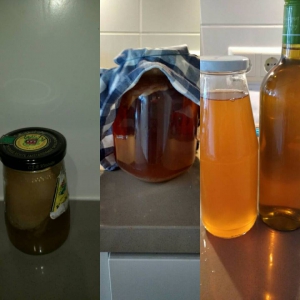 I recently posted the following picture on the right to my social media and was surprised at the volume of response I received. I have had problems with my digestion in the past and I drink kombucha regularly to help it along. It takes a few steps to make kombucha so I asked my friend Joyce who is a Nutrition Therapist to write a guest blog to explain what it is and how to make it.
I recently posted the following picture on the right to my social media and was surprised at the volume of response I received. I have had problems with my digestion in the past and I drink kombucha regularly to help it along. It takes a few steps to make kombucha so I asked my friend Joyce who is a Nutrition Therapist to write a guest blog to explain what it is and how to make it.
The 3 Q’s of Kombucha
In a recent Facebook post from Wilson’s Workouts, Lorna was talking about the kombucha she had just made. A lot of you responded so we thought it would be good to dispel some answers to your questions.
What is kombucha? How do you make it? Why would you make it? Read on and then you can decide if it’s something you want to try.
What is Kombucha?
If you look at a glass of kombucha, you’ll see a dark liquid, the colour of tea. That’s because that’s what it is, it’s tea! It’s a sweetened tea, usually black or green tea, that has been fermented. That means that it is a light, refreshing, sparkling drink.
As always with fermentation, there is some type of bacteria or yeast that are involved. If you’re making a face right now, I completely understand, but wine, beer and yoghurt are also made in the same way.
With kombucha the active ingredient is called a S.C.O.B.Y. or Mother. SCOBY stands for:
S – symbiotic
C – culture
O – of
B – bacteria (and)
Y – yeast
While a SCOBY is not a pretty thing, it’s harmless to you and helps make your kombucha sparkling and delicious!
Why make Kombucha?
Now the purpose of fermentation of food in general is to deprive a food of air to prevent mould from forming…in other words to keep your food from making you sick!
Other reasons to ferment foods like kombucha:
1. Preserve foods
When food is fermented it has been deprived of oxygen. Along with light, temperature and time, oxygen is an element that contributes to the degradation of your food. By depriving your food of oxygen (usually in a liquid) you help the food last longer.
Whether it’s a vegetable ferment, like sauerkraut, or dairy, like yoghurt, the food lasts longer.
The other thing is that while one organism (like mould) is prevented from growing, another one flourishes (like the SCOBY). This lets you make more delicious kombucha!
2. Increase the nutrition of foods
This is a major factor in having fermented foods like kombucha and recent research is proving more and more how important the bacteria in your body is. It contributes to your microbiome.
- Digestibility
The fermentation process breaks down fibres and partially digests it. This may be especially useful in people that have low stomach acid (many of us do!), who can’t tolerate lactose in milk or who experience IBS, diarrhoea and constipation.
You could call even it pre-digestion, meaning also that you don’t use up so much energy.
- Bioavailability
Sometimes nutrients cannot be released from a food without some sort of alteration. This may be cooking as lycopene in tomatoes increases with cooking, or it could be fermentation.
- Nutrients
Fermented foods produce nutrients, including folic acid, vitamins B1, B2 and B3 as well as biotin. This is good for energy levels.
- Detoxification
Fermentation sometimes detoxifies our foods. It may help break down phytic acid, oxalic acid and cyanides. For example, cassava root, a staple in some African countries, is soaked a long time before cooking. This helps break down the cyanide that would otherwise accumulate in the body and cause health problems.
The live cultures themselves may help detoxify chlorine, antibiotics, alcohol and help add to a healthy gut culture (your microbiome).
3. Increase flavour of foods
When you walk into a deli and you smell the delicious cheese, olives and breads, you are smelling the delights of the fermenting world…did you know that?
Other foods that are a product of fermentation of varying degrees are:
- Prosciutto
- Salami
- Chorizo
- Chocolate
- Coffee
- Wine
- Vanilla
- Vinegar (as well as ketchup, dressings etc)
How is Kombucha Made?
Ferments can be made using a variety of methods and ingredients, but generally the main one is salt or sugar. In the case of kombucha it is sugar. We use sugar to feed the SCOBY and as it grows, it conveys the health benefits and gases to make sparkling kombucha.
Which container?
The vessel that you use to make kombucha is important. As with all ferments, metal will corrode, ruining the flavour and quality of your kombucha. You need to choose glass, clay or food-grade plastic. I use wooden or plastic spoons.
Getting started
You start with making a sweetened tea; black or green, or a combination of both. Don’t use a flavoured tea, such as Earl Grey as the oils from the added bergamot may affect your SCOBY.
It’s best to make your tea the night before as it needs to be room temperature when you add your SCOBY. Follow these steps:
– Make your sweetened tea
– Sterilise your glass or ceramic jar
– Once the tea and jar are cool, add the tea to the jar
– Add your SCOBY
– Add some existing kombucha, just to give your SCOBY a kick start
When is it ready?
It takes about two weeks for your kombucha to be ready to drink and you should bottle it then and store it in the fridge (without the SCOBY in it). The SCOBY can then be used to make your next batch of kombucha.
The recipe
For a detailed kombucha recipe with the exact proportions, click here.
This post was written by Joyce Bergsma, Nutritional Therapist at Joyce Bergsma Nutrition and creator of the Happiness Hub – a place to go for more energy, health and happiness in your life. She gives private consultations in Amsterdam and can be reached at info@eatlivelovefood.com.





[…] this time I was determined. I knew how good fermented foods were for you (you can read about it on the post I wrote for Wilson’s Workouts). This time I was going to try it…WOW, I loved […]